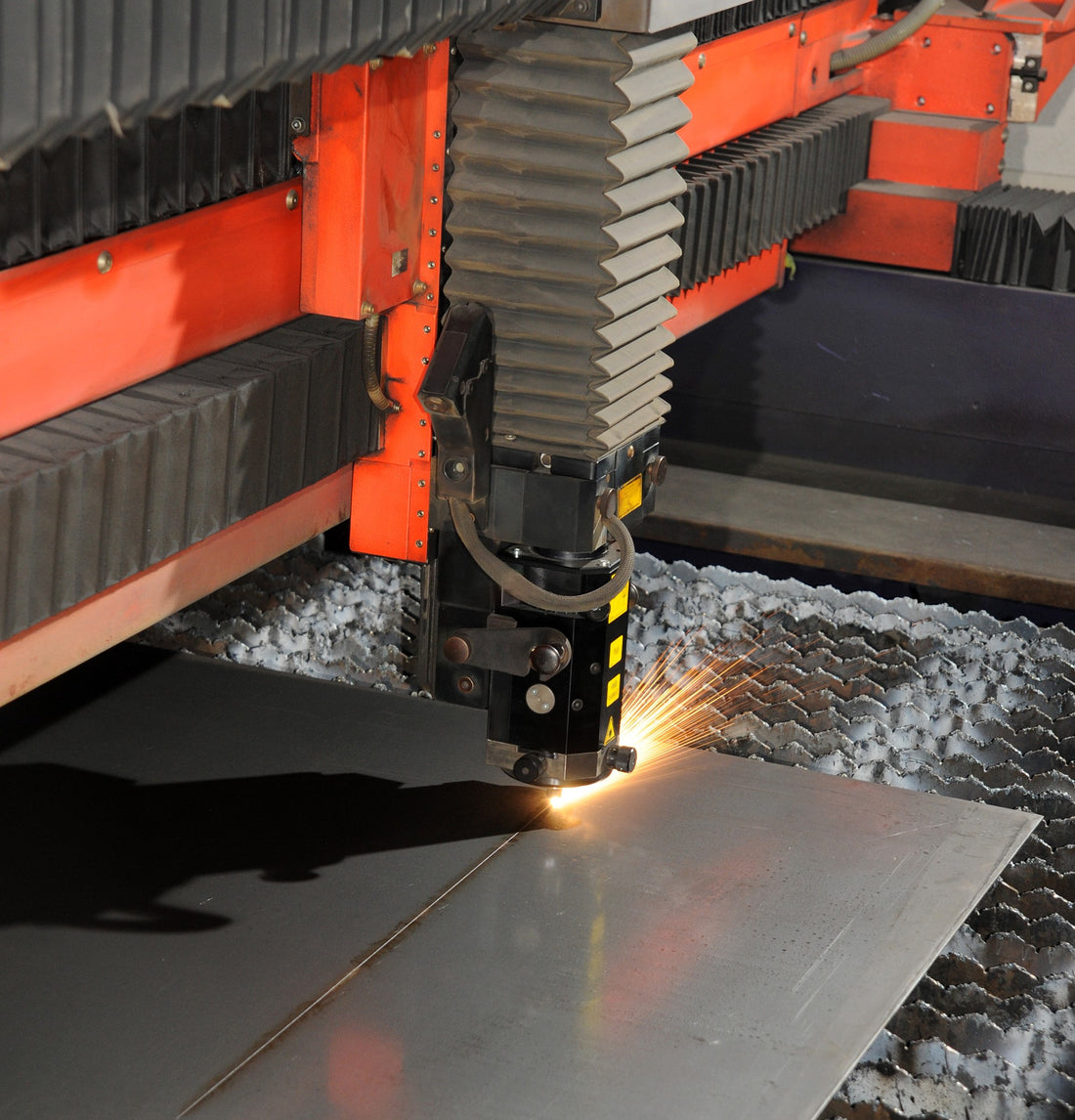A laser enables precise and efficient cutting of numerous materials in industry. Of the CO2 laser works with a carbon dioxide gas mixture And is one of the most powerful lasers. It was developed in the mid -1960s and convinced at the time with a high efficiency and comparatively low acquisition costs. Technology has been further improved in recent years. This gas laser is available in different designs and enables the setting of different power areas for different areas of application.
What is a CO2 laser?
Many people think of one with a laser beam, with which different things can be cut. A CO2 laser belongs to the group of gas lasers and works with a mixture of carbon dioxide, helium and nitrogen. This mixture serves as an active laser medium. The carbon dioxide molecules send out the laser radiation after stimulation by electrodes. In industry there is a carbon dioxide laser next to one Fiber laser One of the most important laser machines. CO2 lasers are an electrically stimulated and work in the distant infrared range with wavelengths around 10,600 nanometers. The output power can be up to 80 kilowatts. Special CO2 lasers can hand in pulse energies of up to 100 kilo joules. There are many different areas of application for a carbon dioxide laser in numerous areas of industry.
The carbon dioxide laser was invented 1964 by laser physicist Kumar Patel in the Bell Laboratories in the USA. This technology has been improved in the last 10 to 15 years. The carbon dioxide laser now has an efficiency of up to 11 percent (for comparison, semiconductor lasers create up to 35% efficiency). CO2 lasers are actually not suitable for use in continuous operation, since the laser source lives continuously decreases due to inevitable leaks and contamination of the gas - regardless of the service life. However, they are often used in a production, since the acquisition costs - and thus a change in the source - are comparatively low on an industrial scale.
How does a CO2 laser work?
In a gas mixture of carbon dioxide, nitrogen and helium, which serves as an active medium, electromagnetic waves in the megahertz area are broadcast. The carbon dioxide molecules are stimulated and brought to a high level of energy. The energy is stored in these molecules as vibration or rotation. A continuously emitting carbon dioxide laser can be stimulated with a high voltage up to 20,000 volts and the resulting glow discharge. The stimulation of the molecules is possible with a high DC voltage or high-frequency change voltage.
The carbon dioxide molecules have different forms of vibration with different energy levels. If an infrared photo meets an excited carbon dioxide molecule, energy is released as a photon. This process is called stimulating emission. The number of photons increases exponentially, If there are enough CO2 molecules. To achieve this, the emitted radiation between two mirrors is directed back and forth by the laser medium. A laser beam is created from the large number of photons, which enables precise cutting.
Avalanche effect through stimulated emissions
In the stimulated emission in CO2 laser, every incident photon that meets a CO2 molecule creates a twin photo-with the same wavelength, direction, phase and polarization. The energy of the carbon dioxide molecule is reduced around the energy of the twin photo. That is the direct consequence of energy conservation. The increase in photons generated by stimulated emissions is called an avalanche effect. The prerequisite for this is enough carbon dioxide molecules.
Engraving or cut through evaporation
The generated laser beam is made via a mirror in the CO2 laser led in the direction of the workpiece to be processed. There is a cutting head directly above the workpiece that focuses on the laser beam. There is a collective lens in the cutting head that bundles the laser beam into a lower diameter.
The CO2 laser is a gas laser And usually works with evaporation. Often, gas is supplied in the cutting head or near the point where the laser beam meets the workpiece. In contrast to evaporation, oxygen is fed with the brick cutting, which supports the cutting process by oxidizing the workpiece. With inert gas, which is mostly argon or nitrogen, the oxidation process is to be minimized.
The point where the laser beam meets the workpiece, is the focus point. With every cutting or engraving process, temperatures that lie above the evaporation temperatures of the workpiece are created at this point. The cut or engraving is usually caused by evaporation.
Different types of CO2 lasers
Different types are differentiated with the CO2 lasers. Basically, the CO2 laser can be divided into four types.
Longitudinal and cross-flowed laser
A longitudinal and cross-flowed CO2 laser has a comparatively simple design and a high output power. With a vacuum pump, a special gas mixture is continuously sucked through the discharge tube. Part of the carbon dioxide, which is contained in the gas mixture, is broken down into carbon monoxide and oxygen by a direct current discharge. In the pipe system there are several pumps that continuously circulate the gas mixture and ensure efficient removal of the loss heat. Due to the high complexity and maintenance effort, this design can only be found in industrial systems with several kilowatts of output power.
Completed laser
The gas mixture is not replaced by a pump in a closed CO2 laser. Ideally, water vapor, hydrogen and oxygen are given to the gas mixture. This mixture ensures that the carbon monoxide is catalytically regenerated into carbon dioxide via an electrode made of platinum. This design is significantly cheaper because the structure does not provide the gas replacement. There is no reprocessing of the gas for particularly cheap laser sources made of glass. Such laser tubes lose performance over time, regardless of the time. Corresponding information is often found in the guarantees (e.g. the guarantee is limited to 3 months or 300 hours, depending on what occurs earlier).
Tea laser
Tea is the abbreviation for transverse electric excitation at atmospheric pressure, which means transverse stimulated atmospheric pressure. A tea laser is used when high gas pressures up to a bar with pulse time are required up to 100 NS. In short pulses of just one microsecond, the discharge voltage is created across the gas flow. Lights are avoided with this design. Short pulse lasers have their area of application exclusively in science and industry.
Wave conductor laser
The wave conductor laser is also known as SLAB laser. It has a cuboid resonator and two electrodes as a wave ladder. Due to the high aspect ratio of the cross -section, the resonator has a large surface compared to the volume. The heat of loss can therefore be removed efficiently.
How is a CO2 laser built up?
A CO2 laser has a gas -filled resonator. This gas is an active medium and creates high radiation services. High -voltage electrodes are usually available to stimulate the gas. There is an electrode on each side of the resonator. Furthermore, the laser has a mirror through which the laser beam is directed to the workpiece. The cutting head is equipped with a collective lens that bundles the laser beam. This cutting head is located above the workpiece. Everything is housed in a housing. Since there are different designs, the structure of the individual designs can differ.
What is the performance of a CO2 laser?
A CO2 laser can achieve an output power up to 100 kilowatts in continuous litter operation. the Performance depends on various parameters:
- Size of the resonator
- wavelength
- Pump energy.
There are varying carbon dioxide lasers. the laser Also enable a setting of various services. Weaker lasers only have one output of up to 400 watts. Stronger lasers are used to cut metals in industry, which have an output of at least 1 to 6 kilowatts.
What are CO2 laser used for?
For what Carbon dioxide laser can be used depends on the performance area. Lasers with low power areas of 10 to 400 watts can be cut, engraving and perforate thin organic materials such as wood, Plastics, acrylic or textiles are used. Trotec from Austria is the market leader for CO2 lasers in these areas of application.
What is a CO2 laser? An industrial laser with an output of 1 to 6 kilowatts can not only be used for cutting, but also for welding, hardening or melting metals. In modern industry they are also used for oxide -free laser cutting. They are particularly suitable for smaller lot sizes in sheet metal processing. With larger quantities, however, punching is more economical.
CO2 laser Can in various industries such as:
- Processing industry
- Metal processing
- mechanical engineering
- Automotive industry
- aviation
- Textile industry
be used. In the textile industry, the laser is suitable, for example, for cutting fabrics.
What materials can be edited with the CO2 laser?
A carbon dioxide laser enables many materials to be processed:
Advantages of laser cutting in general:
- numerous possible uses
- Precise processing of the workpiece without riding line on the edges, so that no ridge later has to be removed
- Precise cuts or engravings even with complex shapes
- The rest of the workpiece is only slightly thermally loaded
- Fast individual programming possible
- Low post -processing at the interface, hence time savings
- even economically with smaller quantities
- Material can be exploited optimally
- High process reliability, which is also guaranteed for repetitions.
Laser advantages and disadvantages of CO2
Carbon dioxide laser have a number of advantages:
- high performance
- are also absorbed by transparent materials
A CO2 laser also has disadvantages

- Comparatively short lifespan
- Lifespan shortens dramatically when used outside 15 - 25 ° C
- In the linked PDF for laser life, you can read it through it again
- Performance drop over time, regardless of the service life
- Efficiency with a maximum of 11% not up to date
- High power consumption
- susceptible to vibration
- Water cooling systems do not allow use at temperatures below 15 ° C
- complicated maintenance
- Complex and susceptible beam guidance with a festive optics structure
- Depending on the ambient temperature, the optics are sometimes necessary to readjust
- not always precisely at Graving metal
Conclusion on the CO2 laser
What is a CO2 laser? A CO2 laser is a gas laser with that A mixture of carbon dioxide, nitrogen and helium serves as an active medium. The carbon dioxide molecules are stimulated. If an infrared photo meets a carbon dioxide molecule, a new photon is created. This stimulated emission leads to an avalanche effect that finally creates the laser beam. The CO2 laser can be used in industry for the processing of various materials. One disadvantage lies in the comparatively short lifespan, the poor efficiency, high power consumption and susceptibility to temperature and vibration.
Cover picture: Copyright @iStockphoto.com / Gizmo




1 comment
very nice